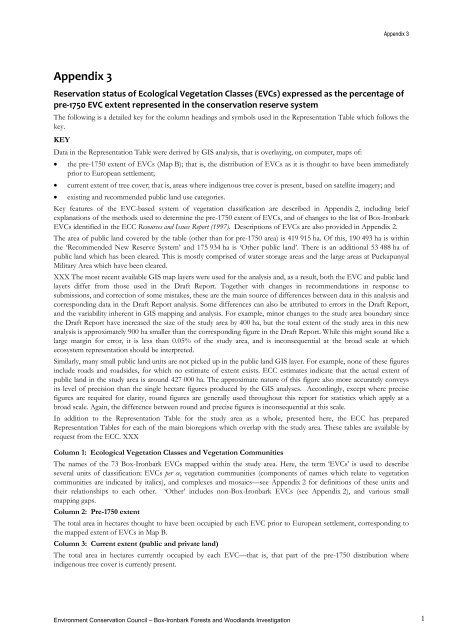Appendix 1 - Victorian Environmental Assessment Council
Appendix 1 - Victorian Environmental Assessment Council
Appendix 1 - Victorian Environmental Assessment Council
You also want an ePaper? Increase the reach of your titles
YUMPU automatically turns print PDFs into web optimized ePapers that Google loves.
<strong>Appendix</strong> 3<br />
<strong>Appendix</strong> 3<br />
Reservation status of Ecological Vegetation Classes (EVCs) expressed as the percentage of<br />
pre‐1750 EVC extent represented in the conservation reserve system<br />
The following is a detailed key for the column headings and symbols used in the Representation Table which follows the<br />
key.<br />
KEY<br />
Data in the Representation Table were derived by GIS analysis, that is overlaying, on computer, maps of:<br />
• the pre-1750 extent of EVCs (Map B); that is, the distribution of EVCs as it is thought to have been immediately<br />
prior to European settlement;<br />
• current extent of tree cover; that is, areas where indigenous tree cover is present, based on satellite imagery; and<br />
• existing and recommended public land use categories.<br />
Key features of the EVC-based system of vegetation classification are described in <strong>Appendix</strong> 2, including brief<br />
explanations of the methods used to determine the pre-1750 extent of EVCs, and of changes to the list of Box-Ironbark<br />
EVCs identified in the ECC Resources and Issues Report (1997). Descriptions of EVCs are also provided in <strong>Appendix</strong> 2.<br />
The area of public land covered by the table (other than for pre-1750 area) is 419 915 ha. Of this, 190 493 ha is within<br />
the ‘Recommended New Reserve System’ and 175 934 ha is ‘Other public land’. There is an additional 53 488 ha of<br />
public land which has been cleared. This is mostly comprised of water storage areas and the large areas at Puckapunyal<br />
Military Area which have been cleared.<br />
XXX The most recent available GIS map layers were used for the analysis and, as a result, both the EVC and public land<br />
layers differ from those used in the Draft Report. Together with changes in recommendations in response to<br />
submissions, and correction of some mistakes, these are the main source of differences between data in this analysis and<br />
corresponding data in the Draft Report analysis. Some differences can also be attributed to errors in the Draft Report,<br />
and the variability inherent in GIS mapping and analysis. For example, minor changes to the study area boundary since<br />
the Draft Report have increased the size of the study area by 400 ha, but the total extent of the study area in this new<br />
analysis is approximately 900 ha smaller than the corresponding figure in the Draft Report. While this might sound like a<br />
large margin for error, it is less than 0.05% of the study area, and is inconsequential at the broad scale at which<br />
ecosystem representation should be interpreted.<br />
Similarly, many small public land units are not picked up in the public land GIS layer. For example, none of these figures<br />
include roads and roadsides, for which no estimate of extent exists. ECC estimates indicate that the actual extent of<br />
public land in the study area is around 427 000 ha. The approximate nature of this figure also more accurately conveys<br />
its level of precision than the single hectare figures produced by the GIS analyses. Accordingly, except where precise<br />
figures are required for clarity, round figures are generally used throughout this report for statistics which apply at a<br />
broad scale. Again, the difference between round and precise figures is inconsequential at this scale.<br />
In addition to the Representation Table for the study area as a whole, presented here, the ECC has prepared<br />
Representation Tables for each of the main bioregions which overlap with the study area. These tables are available by<br />
request from the ECC. XXX<br />
Column 1: Ecological Vegetation Classes and Vegetation Communities<br />
The names of the 73 Box-Ironbark EVCs mapped within the study area. Here, the term ‘EVCs’ is used to describe<br />
several units of classification: EVCs per se, vegetation communities (components of names which relate to vegetation<br />
communities are indicated by italics), and complexes and mosaics—see <strong>Appendix</strong> 2 for definitions of these units and<br />
their relationships to each other. ‘Other’ includes non-Box-Ironbark EVCs (see <strong>Appendix</strong> 2), and various small<br />
mapping gaps.<br />
Column 2: Pre-1750 extent<br />
The total area in hectares thought to have been occupied by each EVC prior to European settlement, corresponding to<br />
the mapped extent of EVCs in Map B.<br />
Column 3: Current extent (public and private land)<br />
The total area in hectares currently occupied by each EVC—that is, that part of the pre-1750 distribution where<br />
indigenous tree cover is currently present.<br />
Environment Conservation <strong>Council</strong> – Box-Ironbark Forests and Woodlands Investigation 1
















